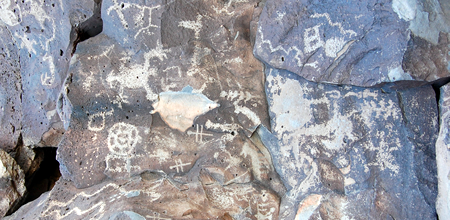
San José de Las Huertas
Galisteo Basin Sites
- Lamy Jct
- Lower Arroyo Hondo Pueblo
- El Camino Real
- Chamisa Locita
- El Crestón
- Espinoso Ridge Pueblo
- La Cienega Pueblo (LA 3)
- La Cienega Pithouse Village
- La Cieneguilla Pueblo (LA 16)
- La Cieneguilla Petroglyphs
- Manzanares Pueblo
- Paa-ko
- Petroglyph Hill
- Pueblo Blanco
- Pueblo Colorado
- Pueblo Galisteo
- Pueblo Largo
- Pueblo San Cristóbal
- Pueblo San Lazaro
- Pueblo Shé
- Rote Chert Quarry
- San José de Las Huertas
- Upper Arroyo Hondo Pueblo
- Pueblo San Marcos
San José de las Huertas is located at the northern end of the Sandia Mountains, northeast of Albuquerque, east of Bernalillo, and south of San Felipe Pueblo.
Established in the mid-1700s on the San Antonio de las Huertas land grant, the site is approximately 1.5 miles (2.5 km) north-northwest of the present-day Placitas, New Mexico. The village remains sit on a large area of a wide, flat terrace at the southwest base of the Cuchilla de Escala hills and to the north of Las Huertas Creek. The creek bed opens into a broad valley at this point, although the creek itself is still well entrenched. The site is further bounded on its northwest side by a small, unnamed, dry wash that empties into Las Huertas Creek directly west of the site. To the east and southeast, the settlement extends some distance up the channel of the creek.

One of the most prominent features currently visible on the ground surface includes a perimeter wall of rubble and adobe remains that surrounds the village. The dimensions of this walled area measure approximately 140 m from northwest to southeast and 270 m along the southwest and northeast sides. The county road, Camino de Rosa Castilla, passes to the north and east of the site and has destroyed a portion of the perimeter wall as well as any associated structures and middens. Low mounds of adobe and cobble alignments located within the village suggest the presence of at least eight to ten structures and four interior walls. The original walls and houses have either been salvaged or eroded over the years. Rumaldo Montoya, a long-time resident of the valley reports that years ago there were walls still standing five or six feet high.
The Spanish colonial village of San José de las Huertas has been well-known by the local inhabitants since its abandonment and has a history of being frequently visited and surface-collected. It is significant as an early Spanish colonial settlement in the central Rio Grande. Because the villagers of Las Huertas were ordered to leave their homes, the abandonment was probably orderly with the villagers removing the possessions they wanted to take with them. Given the nature of the abandonment of the village and the long-time surface collecting at the site, the archaeological deposits at the site are relatively small and fragmentary.
San Jose de las Huertas is in possession and care of the Archaeological Conservancy.

© New Mexico Office of Archaeological Studies, a division of the New Mexico Department of Cultural Affairs.
The Center for New Mexico Archaeology
7 Old Cochiti Road
Santa Fe, NM 87507
505-476-4404
Fax: 505-476-4448

